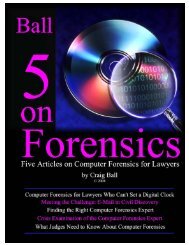Six Articles on Electronic - Craig Ball
Six Articles on Electronic - Craig Ball
Six Articles on Electronic - Craig Ball
Create successful ePaper yourself
Turn your PDF publications into a flip-book with our unique Google optimized e-Paper software.
<strong>Craig</strong> <strong>Ball</strong> © 2007<br />
D<strong>on</strong>'t Try This at Home<br />
By <strong>Craig</strong> <strong>Ball</strong><br />
[Originally published in Law Technology News, August 2005]<br />
The legal assistant <strong>on</strong> the ph<strong>on</strong>e asked, "Can you send us copies of their hard drives?"<br />
As court-appointed Special Master, I'd imaged the c<strong>on</strong>tents of the defendant's computers and<br />
served as custodian of the data for several m<strong>on</strong>ths. The plaintiff's lawyer had been wise to lock<br />
down the data before it disappeared, but like the dog that caught the car, he didn't know what to<br />
do next. Now, with trial a m<strong>on</strong>th away, it was time to start looking at the evidence.<br />
"Not unless the judge orders me to give them to you," I replied.<br />
The court had me act as custodian because the discoverable evidence <strong>on</strong> a hard drive lives<br />
cheek by jowl with all manner of sensitive stuff, such as attorney-client communicati<strong>on</strong>s,<br />
financial records and pictures of naked folks engaged in recreati<strong>on</strong>al activity. In suits between<br />
competitors, intellectual property and trade secrets such as pricing and customer c<strong>on</strong>tact lists<br />
need protecti<strong>on</strong> from disclosure when not evidence. As does all that full-of-surprises deleted<br />
data accessible by forensic examinati<strong>on</strong>.<br />
"Even if the court directs me to turn over the drive images, you probably w<strong>on</strong>'t be able to access<br />
the data without expert assistance."<br />
I explained that, like most computer forensic specialists, I store the c<strong>on</strong>tents of hard drives as a<br />
series of compressed image files, not as bootable hardware that can be attached to a computer<br />
and examined. Doing so is advantageous because the data is easier to access, store and<br />
authenticate, as well as far less pr<strong>on</strong>e to corrupti<strong>on</strong> by the operating system or through<br />
examinati<strong>on</strong>. Specialized software enables me to assemble the image files as a single virtual<br />
hard drive, identical in every way to the original. On those rare occasi<strong>on</strong>s when a physical<br />
duplicate is needed, I rec<strong>on</strong>stitute those image files to a forensically sterile hard drive and use<br />
cryptographic algorithms to dem<strong>on</strong>strate that the restored drive is a faithful counterpart of the<br />
original. Of course, putting the digital toothpaste back in the tube that way takes time and costs<br />
m<strong>on</strong>ey.<br />
"Do we ask the court for a restored drive?"<br />
"You could," I said, "and you might get it if the other side doesn't object."<br />
Incredibly, lawyers who'd never permit the oppositi<strong>on</strong> to fish about in their client's home or office<br />
blithely give the green light when it comes to trolling client hard drives. No matter how much<br />
you want to dem<strong>on</strong>strate good faith or that your client has "nothing to hide," be wary of allowing<br />
the other side to look at the drives.<br />
Even when you've checked the c<strong>on</strong>tents, you can't see all that a forensic exam can turn up, and<br />
your client may not tell you about all those files she deleted last night.<br />
75













